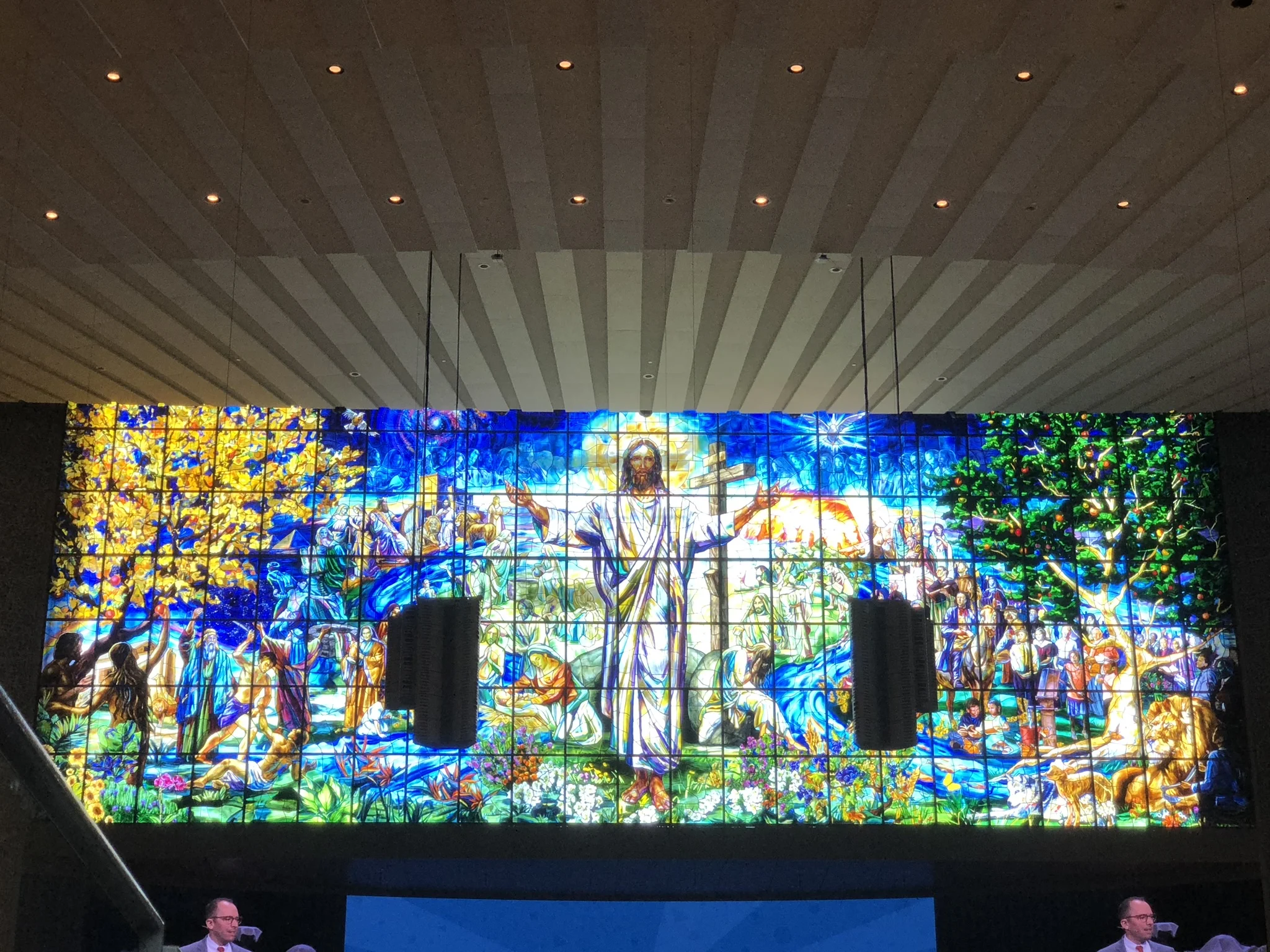The stain glass window in the sanctuary at COR
For the past two weeks, I have had the distinct honor of visiting some of the “industry leaders” inside the United Methodist Church. We've tied this into a family vacation, and hash-tagged it the #adamtour. As we were planning this escapade we noticed all three churches had lead pastors named "Adam" so the #adamtour was born. Today I am going to write on the first two churches and hit the third church in a future blog.
The first church we visited is the United Methodist Church of the Resurrection, and it happens to be the largest church in the UMC. They average somewhere around 20k in worship every week and have several campuses spread about the Kansas City area. Rev. Adam Hamilton is their pastor, and they have created some incredible spaces for people to worship.
Embrace Church on Sunday morning
The second church we got to enjoy is Embrace Church in Sioux Falls, South Dakota. Pastored by Rev. Adam Weber, they have the honor of being the fastest growing Methodist Church in the country. In recent years their growth has been north of 50% a year and now worship somewhere around 4k every week in a community that most people wouldn’t call huge.
What I would like to say at this point is that both places showed amazing hospitality to me as a pastor who is on a mission to learn. High-level leaders sat down with me, answered my absurd number of questions, and treated me as a brother in Christ. Both churches were open, honest, and Kingdom-minded. I can’t tell you how much hope that gave me for the future of the church.
What they had in common…
The first thing that was apparent in both churches is that space matters. While the type of space they were going for was different, each church was incredible intentional with the look, the branding, and overall feel of their environment. Signage was clear, and even if there was no one to point me in the right direction I could find my way even in the most complex settings. Contemporary worship spaces were dark and used intentional lighting to set the feel for the room. It was also obvious to me that the younger families were drawn to this type of environment.
Excellence on Sunday morning was paramount. Hospitality was intentional, worship was excellent, and great teaching has clearly been a cornerstone to these organizations. The worship experience was thought out, and even in video venues of their campuses, it is timed out perfectly.
Both churches still have a time where you stand up and greet your neighbor. I don’t know why, but that really surprised me, and I’m trying to decide how I feel about it.
Both churches used a video venue model (although done completely differently). Not that I had any doubts, but video venues work (and seem to work in every setting). While sometimes it requires a little finesse, both churches have figured out the magic to this idea. And I would suggest that the magic comes in the form of the campus pastor. Campuses seemed to own their campus pastor, and the campus pastor is the connector to the church.
Their kid’s spaces were warm, inviting, and done extremely well with how to check in to the process. This reflects what I mentioned earlier, but I might even go as far as to suggest that parents don’t care as much about the curriculum as they do about the look. Parents want to feel like their kids are going to have fun, and will be safe. That message starts with how the kid's space looks.
Finally, both churches seemed to live in tension with the discipleship pathway. Both use connect groups, which then transition to small groups, but after that, there seemed to be tension on how to make it personal. It was also clear that both churches WANT to make disciples and not just churches. This resonates true with most of the churches I watch/follow/observe, we collectively seem to always be asking the question: How do I make this more than just Sunday morning?
The differences…
One church is super structured, while the other is more grass-roots. I’m not sure if that is a product of the size difference, but Church of the Resurrection (COR) had a set way of doing things, while Embrace was a little more relaxed on how things happen. The only thing that I found Embrace was pretty strict on was their branding/look.
COR was super Methodist in their outward appearance, and if you didn’t know Embrace was Methodist then you wouldn’t have known. This isn’t a condemnation or an endorsement, just an observation. Also, their structures were indicative of that same appearance. COR having Elders and more traditional structure while Embrace seemed to be more flexible in their structure.
Embrace only does one style of worship, and because of that everything could look the same. COR had to live in the reality of having two types of worship. This difference reiterated to me the importance of having dedicated spaces. COR pulls off traditional worship (in part) because they have the space for it. While I must also admit it was weird watching the video venue in a downtown campus (that was super hip) while the preacher stood next to the largest pulpit I’ve ever seen, they seem to find a way to make it work.
Finally, how they set up their staffing structure was a little different. Embrace uses a model that empowers the campus pastor to own the worship (outside of the message). COR was more structured, and most seemed to follow the same setup. This is probably indicative of the financial differences in a 20k person church versus a 4k person church. COR can afford to be more structured.
In Conclusion…
Both churches have found a way to expand the Kingdom of God, and have done it their own way. I’m more convinced now than ever before that there are very few things that are non-negotiable in how we “do” church.
The final thought that deserves mentioning is that both churches have leaders who are brave enough to follow their God calling. Knowing both of their stories is knowing that neither of them would have guessed that this is where their churches would be today. However, obedience to God can lead to amazing things, and today I pray that more leaders can follow their example in obedience.



